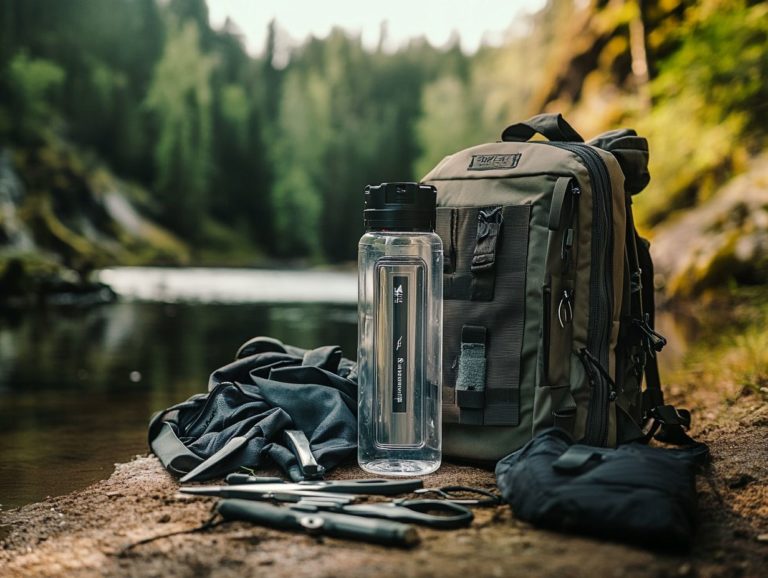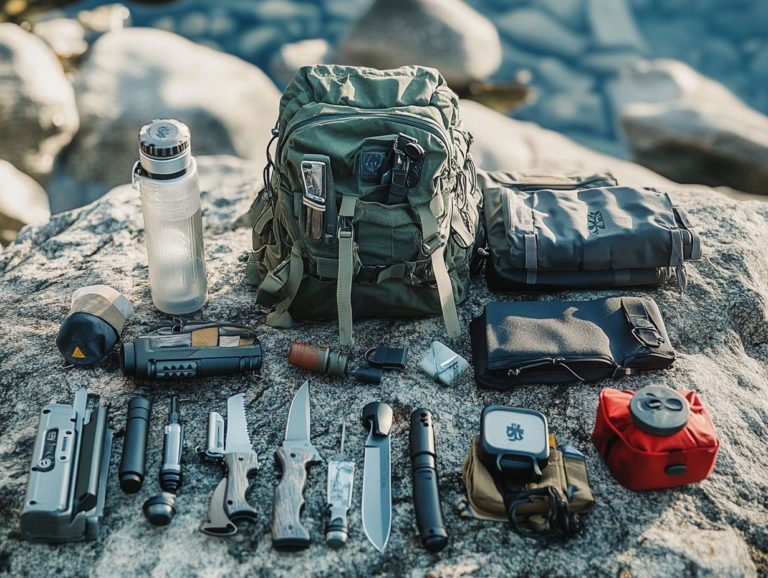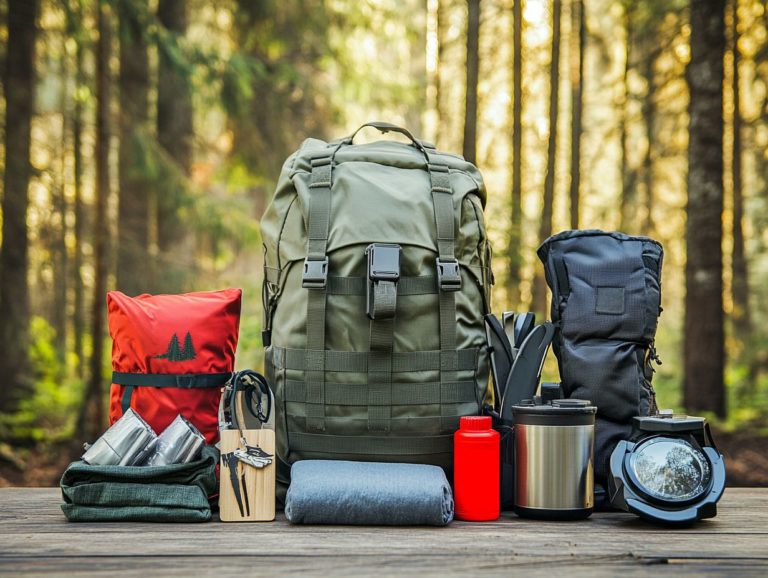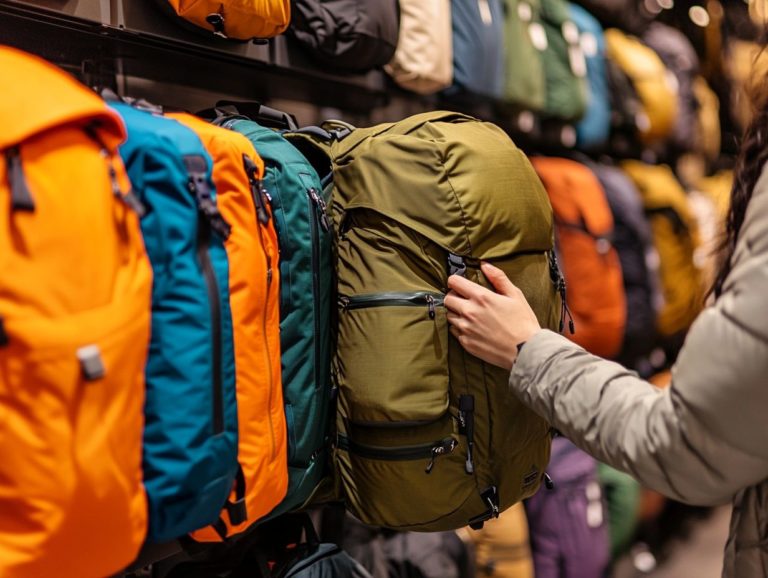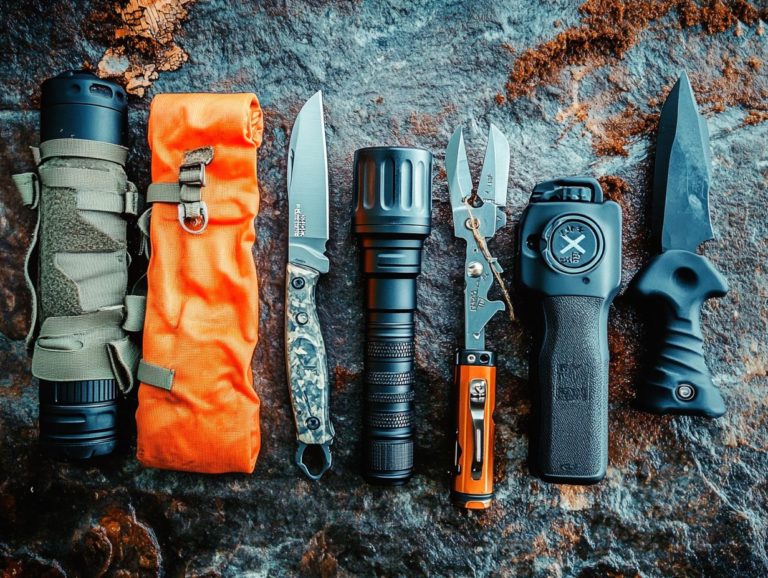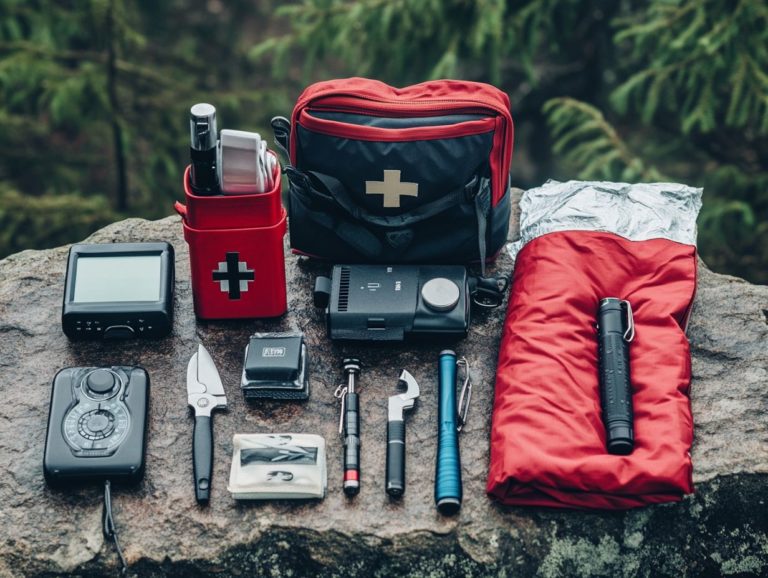Survival Gear for Long-Distance Hikers
Embarking on a long-distance hike is an exhilarating adventure, and having the right hiking gear truly elevates the experience. From navigation tools to essential first aid kits, the items you choose to pack play a crucial role in ensuring your safety and comfort as you explore the great outdoors.
This guide will walk you through the must-have hiking essentials for your journey, illuminate common packing mistakes to avoid, and offer insightful tips on how to lighten your load. Prepare for your trek with confidence, and make every step count!
Contents
- Key Takeaways:
- 1. Navigation and Communication Tools
- 2. Shelter and Sleeping Gear
- 3. Water Filtration and Storage
- 4. Fire-Starting Tools
- 5. First Aid Kit
- 6. Food and Cooking Supplies
- 7. Multi-Tool or Knife
- 8. Clothing and Footwear
- 9. Sun Protection
- 10. Emergency Signaling Devices
- 11. Personal Hygiene Items
- 12. Repair and Maintenance Tools
- 13. Emergency Shelter
- 14. Lighting Equipment
- 15. Insect Repellent
- What Are the Essential Items for a Long-Distance Hike?
- Frequently Asked Questions
- What is considered essential survival gear for long-distance hikers?
- Do I need to invest in expensive survival gear for long-distance hiking?
- What are some important factors to consider when choosing survival gear for long-distance hiking?
- Can I use regular hiking gear as survival gear for long-distance hiking?
- Is it necessary to carry a fire-starting tool as part of my survival gear?
- What should I add to my survival gear for long-distance hiking?
Key Takeaways:
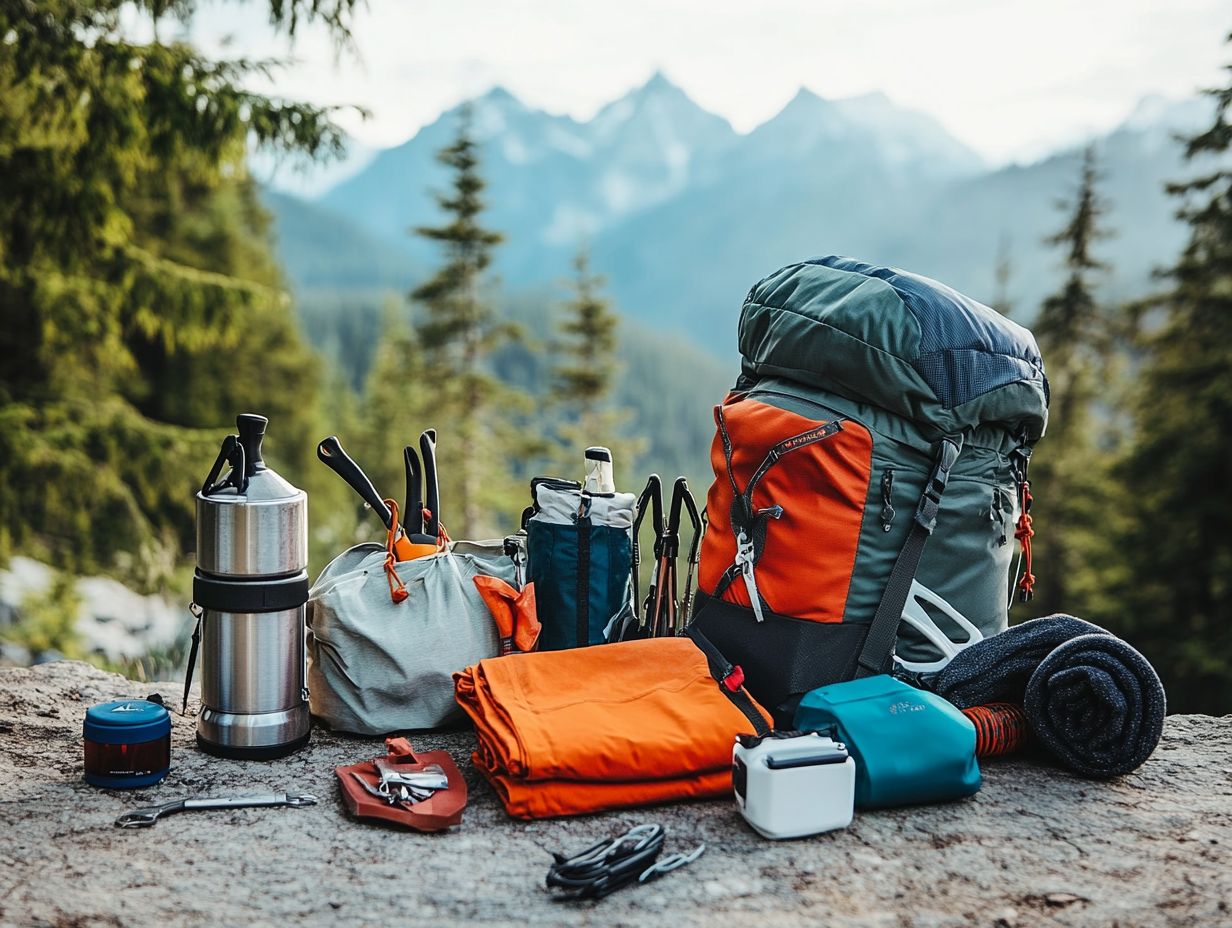
- Pack navigation tools: a GPS, map, and emergency device!
- Choose lightweight shelter options, like a tent or emergency bivvy, for safety and comfort!
- Stay hydrated: bring a water filtration system and storage containers to avoid relying on potentially contaminated natural sources!
When you set off on a hiking adventure, particularly in backcountry areas like Spruce Knob, West Virginia, having the right navigation and communication tools is essential. These tools bolster your safety and enable you to navigate diverse terrains confidently while communicating effectively in emergencies.
Don’t leave without key items like GPS devices, maps, and reliable communication tools in your hiking essentials to avoid getting lost or cut off from your group during backpacking trips.
Among the various options available, GPS units from reputable brands like Garmin shine for their accuracy and durability, making them perfect companions for outdoor excursions. Other brands provide innovative features like preloaded maps and route planning to aid you on your journeys.
Carrying a two-way radio or a satellite messenger is vital, especially in areas lacking cellular service. These devices can serve as a crucial lifeline in emergencies.
By integrating these navigation and communication tools into your comprehensive hiking essentials checklist, you ensure that you are well-prepared, enhancing your outdoor experience while prioritizing safety.
2. Shelter and Sleeping Gear
Choose the right shelter and sleeping gear to boost your comfort and safety during backpacking trips in remote backcountry locations, especially since weather conditions can shift quickly.
A well-chosen tent protects you from unexpected rain, while an emergency bivvy can be a true lifesaver, offering warmth and security when you need it most. A high-quality sleeping bag ensures you stay cozy throughout the night, helping you maintain your energy for the day s hike.
Selecting lightweight gear, like an ultralight jacket, not only lightens your load but also enhances mobility, allowing you to navigate challenging terrains with ease. Together, these essentials create an environment for a restful night, ensuring every outdoor adventure is memorable and enjoyable.
3. Water Filtration and Storage
Staying hydrated is crucial during any hiking or backpacking trip, especially in the backcountry, where clean water can be a rare find. That s why having effective water filtration and storage solutions is essential.
You have several methods for water purification to ensure your water is free from harmful pathogens and impurities. Portable water filters, like the Life Straw, offer a convenient way to sip directly from natural sources. Plus, lighter hydration systems fit seamlessly into your backpack, making hydration on the go easy.
These innovative tools empower you to turn murky streams into safe drinking water, proving their worth on long excursions. You can enhance your hydration with options like Nuun tablets, which replenish electrolytes and elevate your overall hydration game, essential for long backpacking trips. With these hydration systems, you ll stay energized and healthy, ready to tackle whatever adventure lies ahead!
4. Fire-Starting Tools
Fire-starting tools are a lifesaver in emergencies literally! They are an essential part of your hiking survival kit, providing warmth, cooking capabilities, and peace of mind in the backcountry.
In unpredictable conditions, like those at Spruce Knob, West Virginia, having reliable fire-starting methods is crucial for your personal safety. Beyond traditional matches, consider innovative options like magnesium fire flints and waterproof lighters, which cater to various environments and situations.
Your emergency kit should include these tools to ensure that a spark can ignite a much-needed flame, even in adverse weather. Being able to start a fire can mean the difference between life and death, as it offers a signal for rescuers, deters wildlife, and allows you to purify water.
5. First Aid Kit
Don t hit the trails without a well-stocked first aid kit! It s essential for handling minor injuries and medical emergencies during your outdoor adventures.
The right supplies can truly make a difference, whether you’re treating cuts and scrapes or managing sprains and allergic reactions. Important items to include in your kit are:
- Adhesive bandages
- Antiseptic wipes
- Gauze pads
- Scissors
- Pain relief medication
Your personal safety on the trails is paramount. A well-prepared hiker can swiftly address unexpected situations, enhancing both your well-being and the enjoyment of your trip.
When hiking in remote areas, include items like blister treatment and snake bite kits to boost your kit’s effectiveness based on terrain and climate.
6. Food and Cooking Supplies
Don t hit the trails without the right food and cooking supplies they keep your energy high and spirits even higher during long backpacking trips!
When preparing for your hike, opt for lightweight meal options that meet your nutritional needs without weighing you down. Quick-cook pasta, dehydrated fruits, and nutrient-dense energy bars are excellent choices. Portable cooking supplies, such as a stove and lightweight cookware, ensure that meal preparation goes smoothly in the wilderness.
Hydration is just as crucial adding electrolyte tablets to your water helps sustain your stamina. Balancing nutrition and hydration is vital for preventing fatigue, letting you fully immerse yourself in the beauty of the outdoors without compromising your health or safety.
7. Multi-Tool or Knife
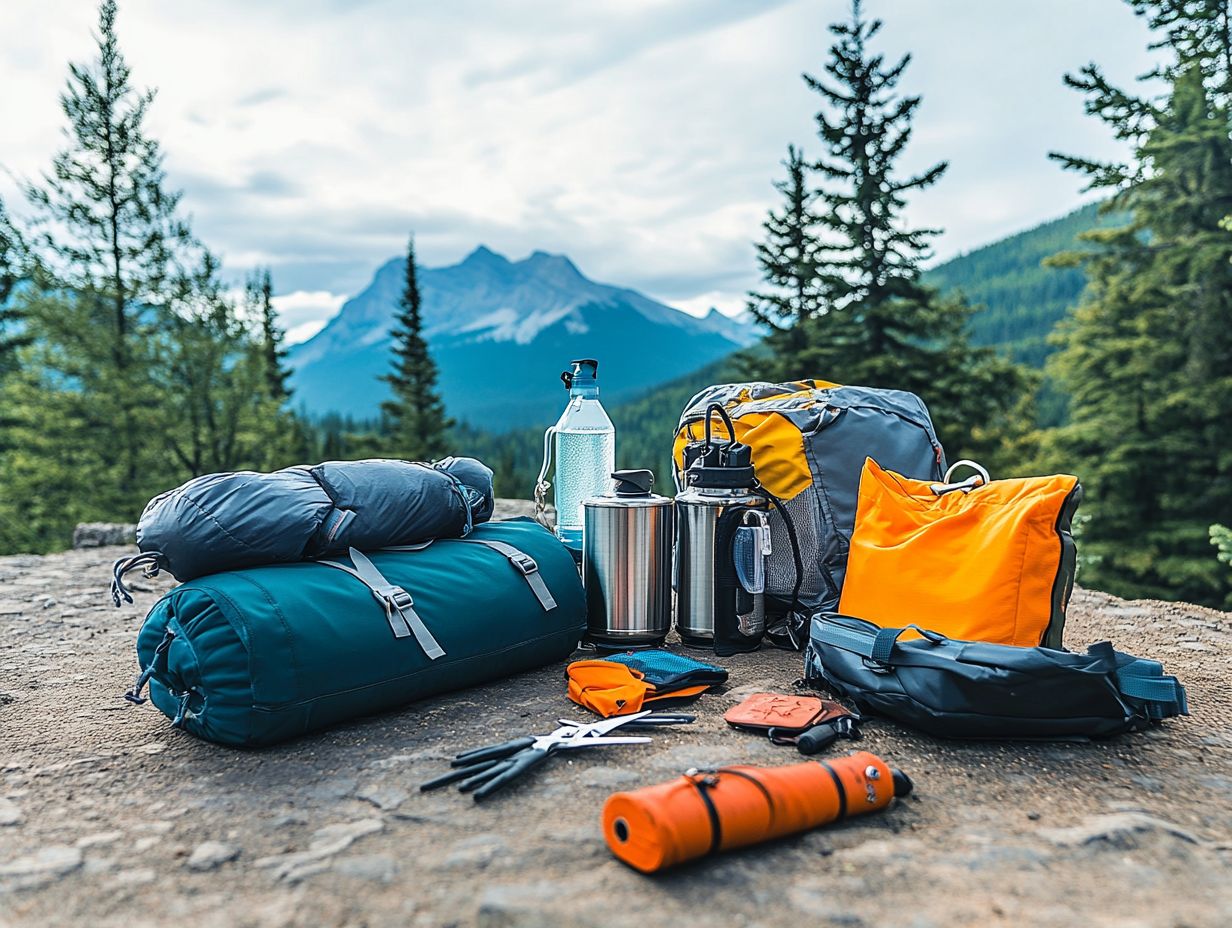
A multi-tool or reliable knife is an essential asset for your emergency kit, offering a blend of functions crucial for survival, maintenance, and everyday tasks during your hiking adventures in Peru.
These tools often come packed with a variety of implements think can openers, screwdrivers, and scissors making them critical companions in the great outdoors. You can effortlessly prepare meals by slicing fruits or vegetables and easily open cans for reliable food supply on your journey.
When unexpected repairs arise, having a multi-tool handy allows you to tackle quick fixes on your gear, ensuring your experience in the wilderness remains safe and enjoyable. Ready access to these versatile instruments significantly enhances your preparedness, especially on long hikes with unanticipated challenges.
Start packing your emergency kit today!
8. Clothing and Footwear
Selecting the right clothing and footwear is essential for your comfort and protection against the elements, especially during your adventures in places like Yosemite or Coronado National Memorial. The appropriate extra layers and gear can significantly elevate your hiking experience while enhancing your personal safety in unpredictable weather.
As you set out on your outdoor adventures, the choice of moisture-wicking fabrics becomes paramount. These materials effectively regulate your body temperature by drawing sweat away from your skin, ensuring you remain dry and comfortable throughout your trek.
Moreover, waterproof layers are critical for those unpredictable weather moments, providing reliable protection against rain and wind. Choosing adaptable and suitable footwear is equally crucial, as it caters to various terrains and minimizes discomfort, reducing the risk of injury.
Having an ultralight jacket readily accessible is a game changer. It’s an easy-to-pack solution that prepares you for sudden weather shifts, allowing you to fully enjoy your journey without worrying about changing conditions.
Are you ready to pack wisely and stay comfortable on your next hike?
9. Sun Protection
Sun protection is often an overlooked essential when it comes to hiking, yet it plays a pivotal role in preventing sunburn and long-term skin damage.
As you embark on your journeys, incorporate various sun protection methods to ensure a safe and enjoyable experience. Wear UV protection clothing made from specialized fabrics that serve as an effective barrier against harmful rays, significantly reducing direct skin exposure. It s crucial to apply broad-spectrum sunscreen, which protects against both UVA and UVB rays, particularly on areas prone to exposure, like your face and the backs of your hands. A wide-brimmed hat provides additional shielding for your face and neck, protecting these sensitive areas from excessive sunlight.
By adopting these protective measures, you enhance your comfort during hikes and invest in the long-term health of your skin. Are you prepared to protect yourself from the sun during your next adventure?
10. Emergency Signaling Devices
Emergency signaling devices are essential lifelines in unexpected situations during your hiking adventures, ensuring you can communicate your location to those who can help.
These devices come in various forms, each tailored to maximize your chances of being found:
- Whistles are incredibly lightweight and can pierce through natural sounds, allowing you to alert others with minimal effort.
- Mirrors can reflect sunlight across long distances, enabling rescue teams to spot you visually from afar.
- Modern GPS communication devices provide real-time tracking and messaging, connecting you directly to help when every second counts.
Each of these tools plays a critical role in enhancing your personal safety. In emergencies, effective communication can mean the difference between life and death.
11. Personal Hygiene Items
Maintaining personal hygiene during your backpacking adventures is crucial for both comfort and health, yet it s often an afterthought when packing essential gear.
Bring biodegradable soap to keep your skin clean without harming the environment, and a dependable toothbrush to maintain your dental health while exploring the great outdoors. Wet wipes can also be a game changer, offering a quick way to freshen up when water access is scarce.
By including these essentials in your packing list, you can significantly enhance your overall well-being on the trail, avoiding illnesses that may arise from neglecting hygiene. This way, your trips can be enjoyable, safe, and hygienically sound. Are you ready to prioritize your hygiene on your next outdoor adventure?
12. Repair and Maintenance Tools
Repair and maintenance tools are essential components of your hiking emergency kit. They enable you to tackle any gear issues that might arise during your journey.
Having a well-equipped kit can truly make the difference between a minor hiccup and a complete derailment of your adventure. Essential items like duct tape allow for quick fixes on torn backpacks or broken tent poles, while a sewing kit can mend clothing tears, keeping you warm and dry.
A multi-tool serves multiple purposes, from opening bottles to tightening loose screws on vital equipment. These tools not only bring you peace of mind but also empower you to manage unexpected challenges, ensuring a more enjoyable and safe experience on the trail.
13. Emergency Shelter
An emergency shelter is a crucial part of your survival kit, providing protection from harsh weather and offering a safe haven during unexpected wilderness situations.
You have various options when it comes to emergency shelters, each designed to meet specific needs. For instance, sleeping bags are compact and lightweight, making them perfect for easy transport and quick setup in a pinch.
Tarps deliver versatile coverage and can be arranged in countless configurations to protect you from rain or wind. Both options are vital for maintaining safety in unforeseen circumstances.
14. Lighting Equipment
Reliable lighting equipment is essential for navigating low-light conditions while hiking. It provides a safe and practical light source to help you avoid accidents.
There are various options available to suit your needs, like headlamps for hands-free illumination or portable lights that you can strategically place along the trail. These tools enhance visibility and significantly contribute to your overall safety.
Understanding the features and benefits of each type will help you choose the best fit for your specific adventures.
15. Insect Repellent
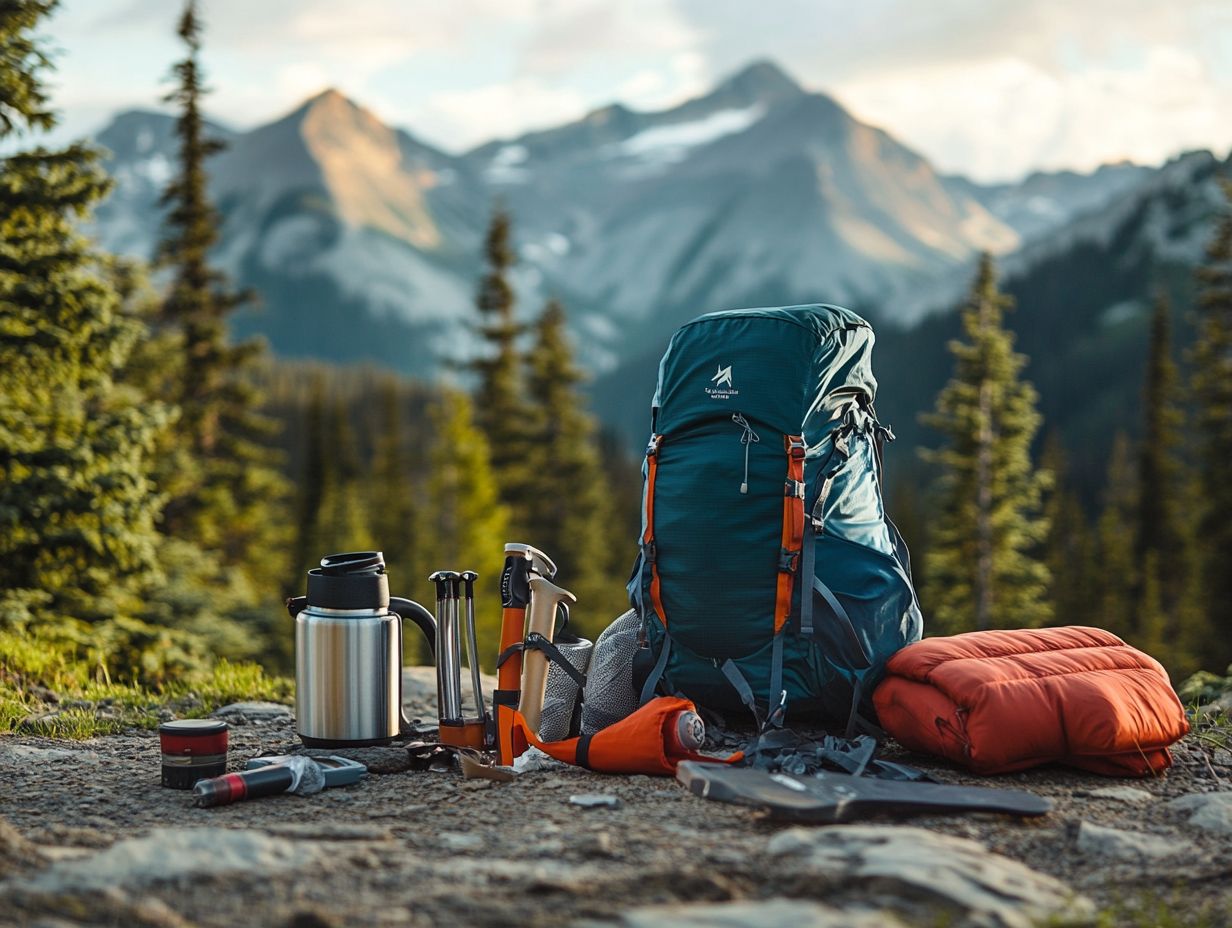
Insect repellent is an often underestimated yet crucial item for your personal safety during hikes, especially in areas where insects thrive.
As you venture into nature, it s essential to explore the various types of insect repellents available, including DEET (a common chemical used in bug spray), picaridin, and natural alternatives like oil of lemon eucalyptus. Each option offers its own level of effectiveness and duration of protection against pesky pests.
By incorporating the right insect repellent into your hiking essentials, you not only reduce the risk of bites but also help prevent the transmission of diseases carried by insects. Being proactive about your insect protection enhances your overall experience in the wild.
What Are the Essential Items for a Long-Distance Hike?
When planning a long-distance hike or backpacking trip, understanding what qualifies as hiking essentials is crucial for ensuring a successful and enjoyable outdoor experience.
Creating a comprehensive gear checklist can significantly elevate your journey. Essential items include:
- Reliable navigation tools maps and compasses to keep you from getting lost.
- Water purification systems, whether portable filters or chemical tablets, to stay hydrated.
- A tailored first aid kit to address potential risks in the area.
- Lightweight, nutritious snacks and meals to sustain energy levels.
With thorough preparation, you’ll lay the groundwork for a rewarding adventure while minimizing the likelihood of unexpected challenges. Get your gear ready today for an unforgettable outdoor experience!
In summary, being well-prepared with the right tools and knowledge can make your long-distance hike both enjoyable and safe.
How Can One Determine the Right Gear to Bring?
Determining the right gear for your hike requires thoughtful consideration of the environment, duration, and your personal needs. This ensures that you re equipped with all the essentials for your adventure.
Factors like climate play a pivotal role. A sunny day might call for sunblock and hats. Cooler temperatures will have you layering up and reaching for insulated gear. The terrain is equally significant; rugged paths demand sturdy boots and trekking poles to maintain your stability.
Your comfort is paramount, as what works for one person might not suit another. This underscores the importance of individual preferences in gear selection. Creating a comprehensive gear checklist can be a game-changer that helps you avoid the oversight of crucial items.
This way, you can embark on your journey well-prepared, allowing you to focus on the experience rather than stressing over what you might have forgotten.
What Are Some Common Mistakes to Avoid When Packing for a Long-Distance Hike?
Packing for a long-distance hike can be exciting! It s all about avoiding common pitfalls to ensure you re fully prepared without the burden of unnecessary weight.
Many hikers find themselves in the all-too-common trap of overpacking. They load their bags with items they think they might need but often leave them untouched. This can lead to a heavy load that slows you down and saps your energy.
Forgetting essential gear like a first-aid kit, a dependable water filter, or weather-appropriate clothing can significantly affect your hike, especially when unexpected conditions arise.
To streamline your packing process, draft a checklist that includes only the must-haves. Consider the climate for appropriate clothing, and opt for multi-use items like a pot that can be used for cooking and as a bowl to maximize space.
Reviewing local trail conditions before you set out can inform your gear choices and enhance your overall hiking experience.
How Can One Cut Down on the Weight of Their Hiking Gear?
Reducing the weight of your hiking gear is essential for achieving both efficiency and comfort during those long treks. It allows for smoother movement and less fatigue.
By choosing ultralight gear, you can significantly lighten your load. This not only boosts your endurance but also elevates your overall outdoor experience. Implementing smart packing techniques, such as using compression bags and selecting multi-use items, ensures that every ounce serves a purpose.
By prioritizing essentials over unnecessary luxuries, you create a streamlined setup that fosters a more focused and fulfilling journey into nature. You can further enhance your hiking experience by carefully assessing your needs and eliminating any duplicates. This results in a well-balanced pack that supports optimal performance without compromising comfort.
What Are Some Tips for Maintaining and Organizing Gear on a Long Hike?
Maintaining and organizing your gear on a long hike is absolutely essential. This ensures easy access to your must-haves and extends the life of your equipment.
Utilizing packing cubes or designated bags can simplify the process of locating items quickly. Compartmentalizing your gear into handy categories like clothing, first aid, and cooking supplies will help immensely. Incorporating a routine of regular maintenance checks boosts performance and offers you peace of mind.
Before you hit the trails, a quick inspection of your gear think tents, backpacks, and cooking utensils can prevent unexpected mishaps and ensure everything works smoothly when you need it most.
A touch of organization and a proactive mindset can truly make a world of difference on the trail.
Frequently Asked Questions
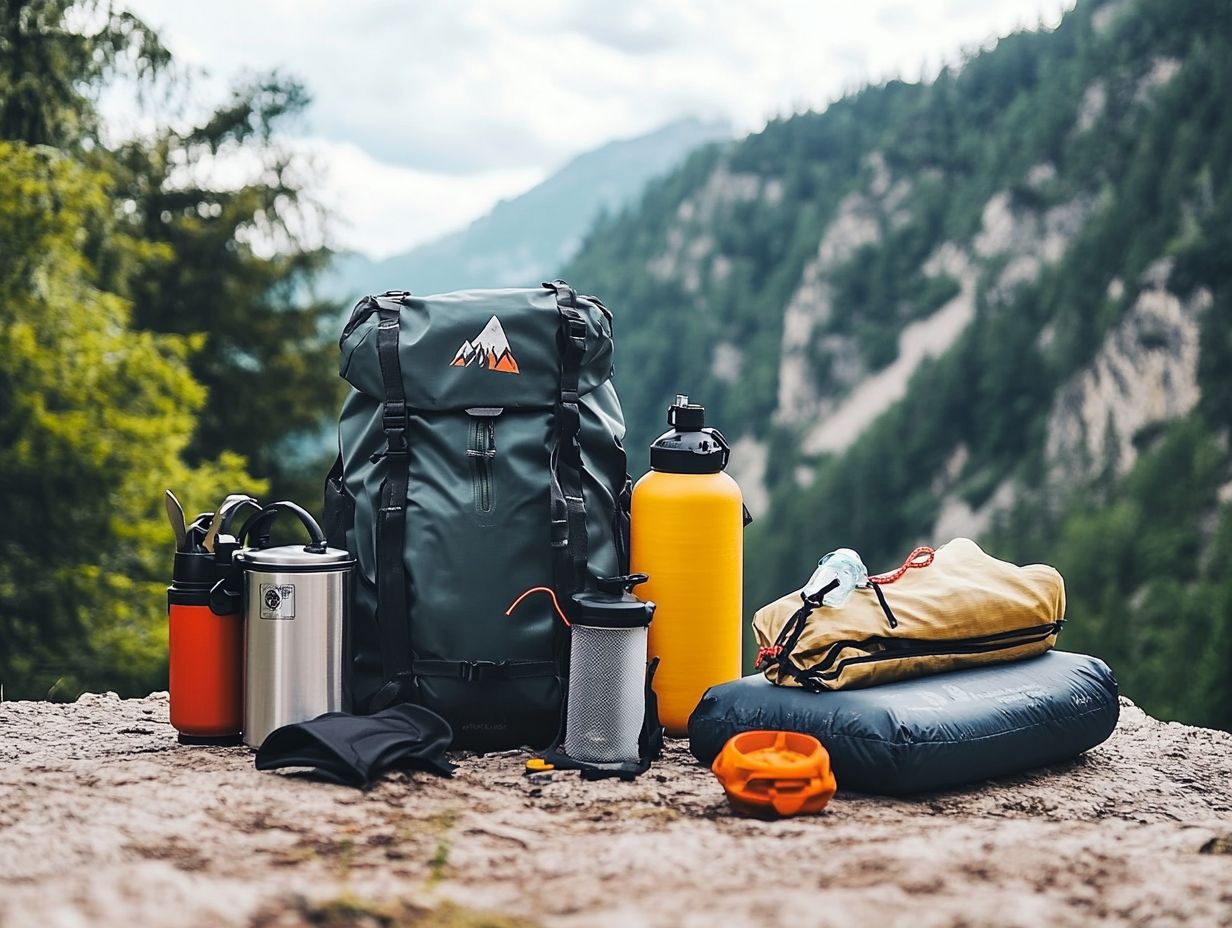
What is considered essential survival gear for long-distance hikers?
- Map and compass
- First aid kit
- Emergency shelter
- Water filtration system
- High-energy snacks
- Multi-tool
Do I need to invest in expensive survival gear for long-distance hiking?
While some high-end gear may offer additional features, it is not necessary. It is more important to choose durable and reliable gear that fits your needs and budget.
We d love to hear from you! Share your own tips or experiences about hiking gear in the comments below.
What are some important factors to consider when choosing survival gear for long-distance hiking?
When choosing survival gear, consider weight, size, durability, and versatility. Make sure the gear is suitable for the climate and terrain you will encounter.
Can I use regular hiking gear as survival gear for long-distance hiking?
Yes, items like a backpack and sturdy shoes can double as survival gear. However, specialized survival equipment is recommended for emergencies.
Is it necessary to carry a fire-starting tool as part of my survival gear?
Absolutely! A fire-starting tool is crucial for warmth, cooking, and signaling for help. Practice using it before you head out.
What should I add to my survival gear for long-distance hiking?
Consider packing a signaling device, extra clothing layers, a headlamp, water purification tablets (which help make unsafe water drinkable), and a lightweight emergency blanket for warmth. Don’t forget Nuun for hydration and a Goal Zero charger to keep your devices powered!

